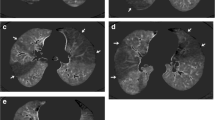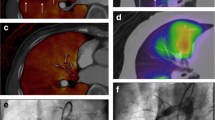Abstract
Objectives
To evaluate the diagnostic accuracy of dual-energy computed tomography (DECT) perfusion and angiography versus ventilation/perfusion (V/Q) scintigraphy in chronic thromboembolic pulmonary hypertension (CTEPH), and to assess the per-segment concordance rate of DECT and scintigraphy.
Methods
Forty consecutive patients with proven pulmonary hypertension underwent V/Q scintigraphy and DECT perfusion and angiography. Each imaging technique was assessed for the location of segmental defects. Diagnosis of CTEPH was established when at least one segmental perfusion defect was detected by scintigraphy. Diagnostic accuracy of DECT perfusion and angiography was assessed and compared with scintigraphy. In CTEPH patients, the per-segment concordance between scintigraphy and DECT perfusion/angiography was calculated.
Results
Fourteen patients were diagnosed with CTEPH and 26 with other aetiologies. DECT perfusion and angiography correctly identified all CTEPH patients with sensitivity/specificity values of 1/0.92 and 1/0.93, respectively. At a segmental level, DECT perfusion showed moderate agreement (κ = 0.44) with scintigraphy. Agreement between CT angiography and scintigraphy ranged from fair (κ = 0.31) to slight (κ = 0.09) depending on whether completely or partially occlusive patterns were considered, respectively.
Conclusions
Both DECT perfusion and angiography show satisfactory performance for the diagnosis of CTEPH. DECT perfusion is more accurate than angiography at identifying the segmental location of abnormalities.
Key Points
• Chronic thromboembolic pulmonary hypertension (CTEPH) is potentially treatable by surgery.
• Dual-energy computed tomography (DECT) allows angiography and perfusion using a single acquisition.
• Both DECT perfusion and angiography showed satisfactory diagnostic performance in CTEPH.
• DECT perfusion was more accurate than angiography in identifying segmental abnormalities.



Similar content being viewed by others
References
Galie N, Hoeper MM, Humbert M et al (2009) Guidelines for the diagnosis and treatment of pulmonary hypertension: the Task Force for the Diagnosis and Treatment of Pulmonary Hypertension of the European Society of Cardiology (ESC) and the European Respiratory Society (ERS), endorsed by the International Society of Heart and Lung Transplantation (ISHLT). Eur Heart J 30:2493–2537
Pengo V, Lensing AW, Prins MH et al (2004) Incidence of chronic thromboembolic pulmonary hypertension after pulmonary embolism. N Engl J Med 350:2257–2264
Jenkins DP, Madani M, Mayer E et al (2013) Surgical treatment of chronic thromboembolic pulmonary hypertension. Eur Respir J 41:735–742
Fedullo P, Kerr KM, Kim NH, Auger WR (2011) Chronic thromboembolic pulmonary hypertension. Am J Respir Crit Care Med 183:1605–1613
Auger WR, Fedullo PF, Moser KM, Buchbinder M, Peterson KL (1992) Chronic major-vessel thromboembolic pulmonary artery obstruction: appearance at angiography. Radiology 182:393–398
Tunariu N, Gibbs SJ, Win Z et al (2007) Ventilation-perfusion scintigraphy is more sensitive than multidetector CTPA in detecting chronic thromboembolic pulmonary disease as a treatable cause of pulmonary hypertension. J Nucl Med 48:680–684
He J, Fang W, Lv B et al (2012) Diagnosis of chronic thromboembolic pulmonary hypertension: comparison of ventilation/perfusion scanning and multidetector computed tomography pulmonary angiography with pulmonary angiography. Nucl Med Commun 33:459–463
Reichelt A, Hoeper MM, Galanski M, Keberle M (2009) Chronic thromboembolic pulmonary hypertension: evaluation with 64-detector row CT versus digital subtraction angiography. Eur J Radiol 71:49–54
Sugiura T, Tanabe N, Matsuura Y et al (2013) Role of 320-slice computed tomography in the diagnostic workup of patients with chronic thromboembolic pulmonary hypertension. Chest 143:1070–1077
Oikonomou A, Dennie CJ, Muller NL, Seely JM, Matzinger FR, Rubens FD (2004) Chronic thromboembolic pulmonary arterial hypertension: correlation of postoperative results of thromboendarterectomy with preoperative helical contrast-enhanced computed tomography. J Thorac Imaging 19:67–73
Thieme SF, Johnson TR, Lee C et al (2009) Dual-energy CT for the assessment of contrast material distribution in the pulmonary parenchyma. AJR Am J Roentgenol 193:144–149
Bauer RW, Kerl JM, Weber E et al (2011) Lung perfusion analysis with dual energy CT in patients with suspected pulmonary embolism–influence of window settings on the diagnosis of underlying pathologies of perfusion defects. Eur J Radiol 80:e476–e482
Fink C, Johnson TR, Michaely HJ et al (2008) Dual-energy CT angiography of the lung in patients with suspected pulmonary embolism: initial results. Rofo 180:879–883
Gorgos A, Remy-Jardin M, Duhamel A et al (2009) Evaluation of peripheral pulmonary arteries at 80 kV and at 140 kV: dual-energy computed tomography assessment in 51 patients. J Comput Assist Tomogr 33:981–986
Pontana F, Faivre JB, Remy-Jardin M et al (2008) Lung perfusion with dual-energy multidetector-row CT (MDCT): feasibility for the evaluation of acute pulmonary embolism in 117 consecutive patients. Acad Radiol 15:1494–1504
Thieme SF, Graute V, Nikolaou K et al (2012) Dual energy CT lung perfusion imaging–correlation with SPECT/CT. Eur J Radiol 81:360–365
Torbicki A, Perrier A, Konstantinides S et al (2008) Guidelines on the diagnosis and management of acute pulmonary embolism: the Task Force for the Diagnosis and Management of Acute Pulmonary Embolism of the European Society of Cardiology (ESC). Eur Heart J 29:2276–2315
Hoey ET, Mirsadraee S, Pepke-Zaba J, Jenkins DP, Gopalan D, Screaton NJ (2011) Dual-energy CT angiography for assessment of regional pulmonary perfusion in patients with chronic thromboembolic pulmonary hypertension: initial experience. AJR Am J Roentgenol 196:524–532
Nakazawa T, Watanabe Y, Hori Y et al (2011) Lung perfused blood volume images with dual-energy computed tomography for chronic thromboembolic pulmonary hypertension: correlation to scintigraphy with single-photon emission computed tomography. J Comput Assist Tomogr 35:590–595
Renard B, Remy-Jardin M, Santangelo T et al (2011) Dual-energy CT angiography of chronic thromboembolic disease: can it help recognize links between the severity of pulmonary arterial obstruction and perfusion defects? Eur J Radiol 79:467–472
Johnson TR, Krauss B, Sedlmair M et al (2007) Material differentiation by dual energy CT: initial experience. Eur Radiol 17:1510–1517
Boyden EA (1954) Segmental anatomy of the lungs. McGraw Hill, New York
van Beers EJ, van Eck-Smit BL, Mac Gillavry MR et al (2008) Large and medium-sized pulmonary artery obstruction does not play a role of primary importance in the etiology of sickle-cell disease-associated pulmonary hypertension. Chest 133:646–652
Kang MJ, Park CM, Lee CH, Goo JM, Lee HJ (2010) Focal iodine defects on color-coded iodine perfusion maps of dual-energy pulmonary CT angiography images: a potential diagnostic pitfall. AJR Am J Roentgenol 195:W325–W330
Ley S, Ley-Zaporozhan J, Pitton MB et al (2012) Diagnostic performance of state-of-the-art imaging techniques for morphological assessment of vascular abnormalities in patients with chronic thromboembolic pulmonary hypertension (CTEPH). Eur Radiol 22:607–616
Heinrich M, Uder M, Tscholl D, Grgic A, Kramann B, Schafers HJ (2005) CT scan findings in chronic thromboembolic pulmonary hypertension: predictors of hemodynamic improvement after pulmonary thromboendarterectomy. Chest 127:1606–1613
Godoy MC, Naidich DP, Marchiori E et al (2009) Basic principles and postprocessing techniques of dual-energy CT: illustrated by selected congenital abnormalities of the thorax. J Thorac Imaging 24:152–159
Bergin CJ, Sirlin CB, Hauschildt JP et al (1997) Chronic thromboembolism: diagnosis with helical CT and MR imaging with angiographic and surgical correlation. Radiology 204:695–702
Remy-Jardin M, Duhamel A, Deken V, Bouaziz N, Dumont P, Remy J (2005) Systemic collateral supply in patients with chronic thromboembolic and primary pulmonary hypertension: assessment with multi-detector row helical CT angiography. Radiology 235:274–281
Remy-Jardin M, Faivre JB, Pontana F et al (2010) Thoracic applications of dual energy. Radiol Clin North Am 48:193–205
Henzler T, Barraza JM Jr, Nance JW Jr et al (2011) CT imaging of acute pulmonary embolism. J Cardiovasc Comput Tomogr 5:3–11
Author information
Authors and Affiliations
Corresponding author
Rights and permissions
About this article
Cite this article
Dournes, G., Verdier, D., Montaudon, M. et al. Dual-energy CT perfusion and angiography in chronic thromboembolic pulmonary hypertension: diagnostic accuracy and concordance with radionuclide scintigraphy. Eur Radiol 24, 42–51 (2014). https://doi.org/10.1007/s00330-013-2975-y
Received:
Revised:
Accepted:
Published:
Issue Date:
DOI: https://doi.org/10.1007/s00330-013-2975-y




